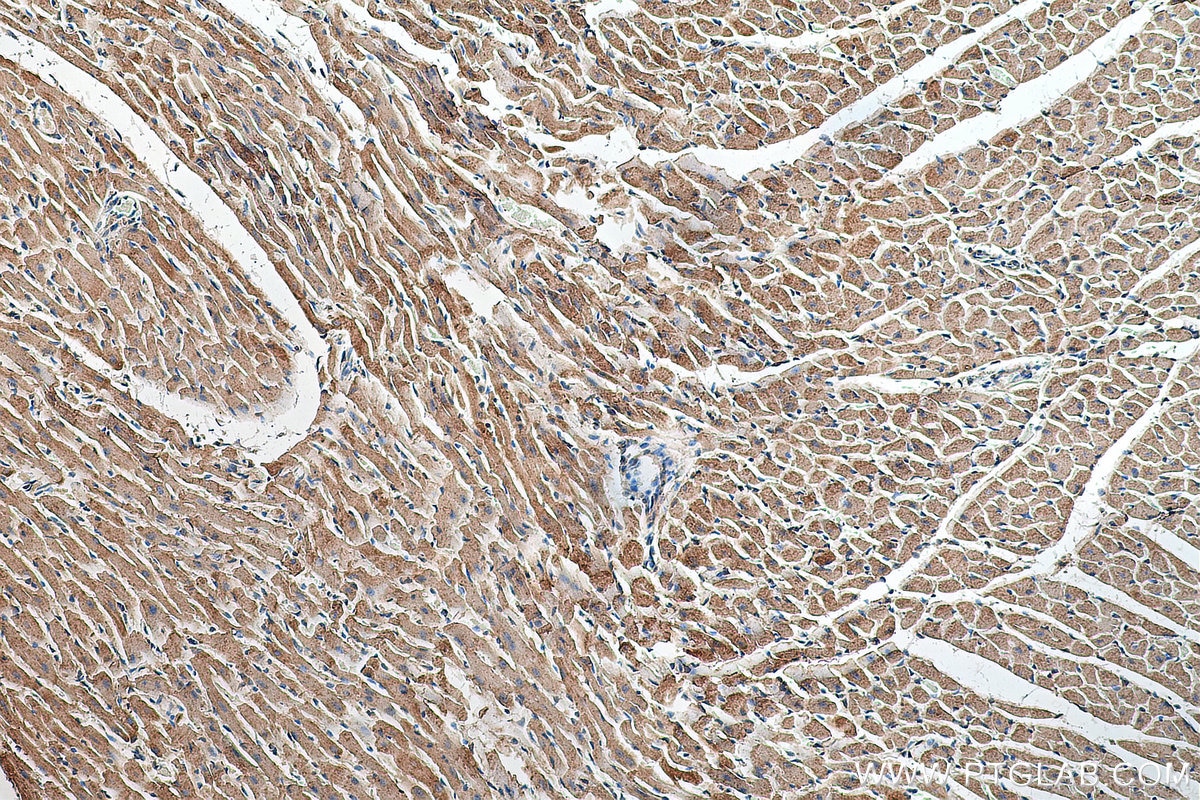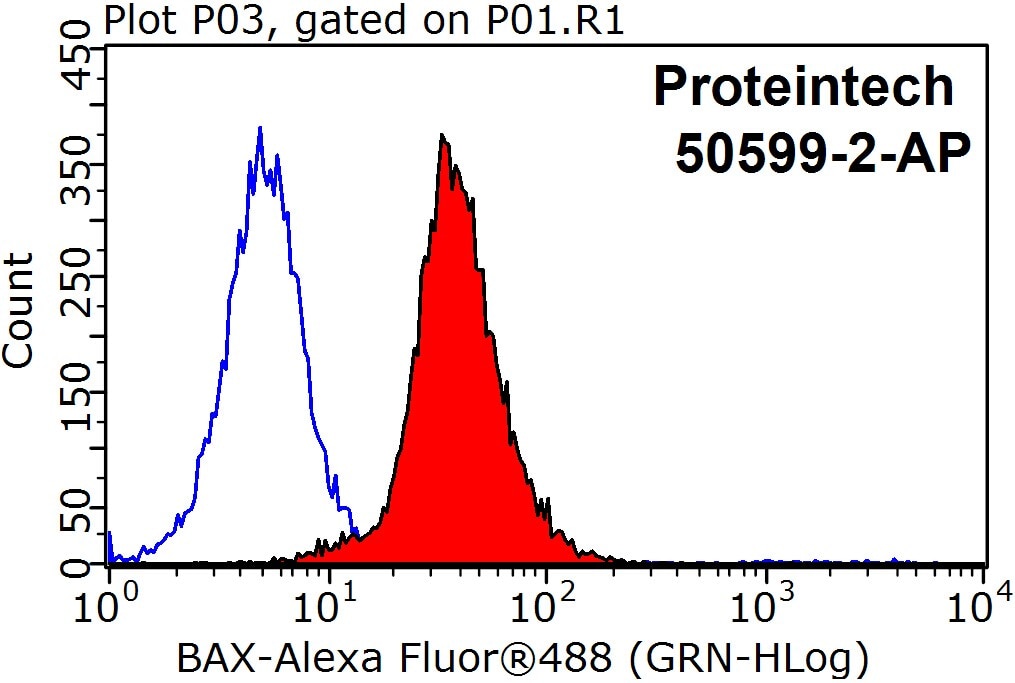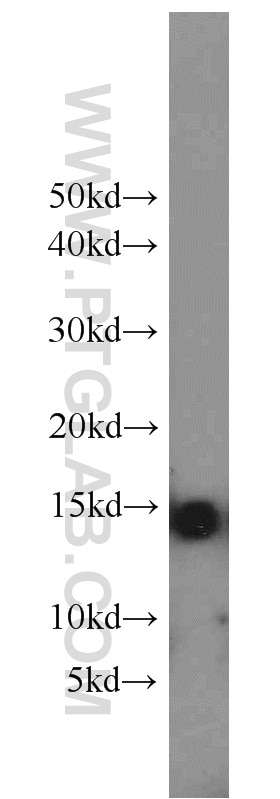- Phare
- Validé par KD/KO
Anticorps Polyclonal de lapin anti-VDAC1/2
VDAC1/2 Polyclonal Antibody for WB, IHC, IF-P, FC (Intra), ELISA
Hôte / Isotype
Lapin / IgG
Réactivité testée
Humain, rat, souris et plus (4)
Applications
WB, IHC, IF-P, FC (Intra), CoIP, ELISA
Conjugaison
Non conjugué
155
N° de cat : 10866-1-AP
Synonymes
"VDAC1/2 Antibodies" Comparison
View side-by-side comparison of VDAC1/2 antibodies from other vendors to find the one that best suits your research needs.
Applications testées
| Résultats positifs en WB | cellules HEK-293, cellules 4T1, cellules C6, cellules Jurkat, cellules MCF-7, cellules MDA-MB-453s, tissu rénal de rat, tissu rénal de souris |
| Résultats positifs en IHC | tissu de côlon humain, tissu cardiaque de souris il est suggéré de démasquer l'antigène avec un tampon de TE buffer pH 9.0; (*) À défaut, 'le démasquage de l'antigène peut être 'effectué avec un tampon citrate pH 6,0. |
| Résultats positifs en IF-P | tissu de cancer du foie humain, tissu hépatique de souris |
| Résultats positifs en FC (Intra) | cellules HepG2, |
Dilution recommandée
| Application | Dilution |
|---|---|
| Western Blot (WB) | WB : 1:500-1:3000 |
| Immunohistochimie (IHC) | IHC : 1:50-1:500 |
| Immunofluorescence (IF)-P | IF-P : 1:100-1:400 |
| Flow Cytometry (FC) (INTRA) | FC (INTRA) : 0.80 ug per 10^6 cells in a 100 µl suspension |
| It is recommended that this reagent should be titrated in each testing system to obtain optimal results. | |
| Sample-dependent, check data in validation data gallery | |
Applications publiées
| KD/KO | See 2 publications below |
| WB | See 144 publications below |
| IHC | See 3 publications below |
| IF | See 10 publications below |
| CoIP | See 2 publications below |
Informations sur le produit
10866-1-AP cible VDAC1/2 dans les applications de WB, IHC, IF-P, FC (Intra), CoIP, ELISA et montre une réactivité avec des échantillons Humain, rat, souris
| Réactivité | Humain, rat, souris |
| Réactivité citée | rat, Humain, Lapin, poisson-zèbre, porc, singe, souris |
| Hôte / Isotype | Lapin / IgG |
| Clonalité | Polyclonal |
| Type | Anticorps |
| Immunogène | VDAC1/2 Protéine recombinante Ag1144 |
| Nom complet | voltage-dependent anion channel 1 |
| Masse moléculaire calculée | 31 kDa |
| Poids moléculaire observé | 31 kDa |
| Numéro d’acquisition GenBank | BC008482 |
| Symbole du gène | Porin |
| Identification du gène (NCBI) | 7416 |
| Conjugaison | Non conjugué |
| Forme | Liquide |
| Méthode de purification | Purification par affinité contre l'antigène |
| Tampon de stockage | PBS avec azoture de sodium à 0,02 % et glycérol à 50 % pH 7,3 |
| Conditions de stockage | Stocker à -20°C. Stable pendant un an après l'expédition. L'aliquotage n'est pas nécessaire pour le stockage à -20oC Les 20ul contiennent 0,1% de BSA. |
Informations générales
VDAC1, also named as VDAC, porin 31HM, porin 31HL and plasmalemmal porin, belongs to the eukaryotic mitochondrial porin family. It adopts an open conformation at low or zero membrane potential and a closed conformation at potentials above 30-40 mV, to form a channel through the mitochondrial outer membrane and also the plasma membrane. Unlike other membrane transport proteins, porins are large enough to allow passive diffusion. Studies have shown that VDAC1 is subject to both phosphorylation and acetylation (PMID: 23233904). The apparent molecular weight of VDAC1 is 30-37 kDa (PMID: 14573604; 23754752; 25681439). Hypoxic conditions were found to trigger cleavage of the VDAC1 C-terminal to yield a 26-kDa truncated but active form (PMID: 22389449; 23233904). This polyclonal antibody raised against full-length human VDAC1 protein can cross react with VDAC2.
Protocole
| Product Specific Protocols | |
|---|---|
| WB protocol for VDAC1/2 antibody 10866-1-AP | Download protocol |
| IHC protocol for VDAC1/2 antibody 10866-1-AP | Download protocol |
| IF protocol for VDAC1/2 antibody 10866-1-AP | Download protocol |
| Standard Protocols | |
|---|---|
| Click here to view our Standard Protocols |
Publications
| Species | Application | Title |
|---|---|---|
Signal Transduct Target Ther Targeting CRL4 suppresses chemoresistant ovarian cancer growth by inducing mitophagy | ||
Nat Cell Biol AIDA directly connects sympathetic innervation to adaptive thermogenesis by UCP1. | ||
Cell Rep Med Urolithin A improves muscle strength, exercise performance, and biomarkers of mitochondrial health in a randomized trial in middle-aged adults. | ||
Cell Res DNA damage triggers tubular endoplasmic reticulum extension to promote apoptosis by facilitating ER-mitochondria signaling. | ||
Acta Pharm Sin B Histone deacetylase inhibitors inhibit cervical cancer growth through Parkin acetylation-mediated mitophagy. | ||
Avis
The reviews below have been submitted by verified Proteintech customers who received an incentive forproviding their feedback.
FH Macarena (Verified Customer) (10-07-2022) | Good results for both IP and WB
|
FH Alberto (Verified Customer) (01-09-2020) | Clear sharp band at the expected molecular weight.
 |
FH Wanxia (Verified Customer) (10-22-2019) | Excellent WB results and very low background.
|





















